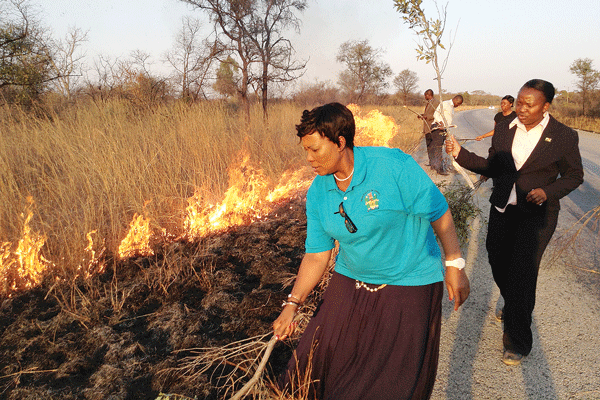
HUNTING has been traditionally revered, particularly in rural areas, where it has always been a mark of noble manhood and marksmanship defined by the ability to use the spear and bow and arrow to bring down prey.
BY JAIROS SAUNYAMA

Things, however, have since changed with the current generation of hunters in the rural areas accused of engaging in illegal and dangerous practices detrimental to the environment.
The use of fire in hunting expeditions has triggered veld fires in Mashonaland East Province, with recent reports revealing that apart from land clearing, hunting using fire is the major cause of the fires destroying the environment.
“There is a lot of grass and hunting is difficult. The rabbits and other wild animals hide in the grass, hence to expose them we have to set the grass ablaze. We are aware that it is illegal, but we survive on hunting,” a 21-year-old Wedza herdboy said.
According to an annual 2016 report by the Environmental Management Agency (EMA), the province recorded a 31,4% increase of burnt area, with hunting being one of the major causes of veld fires.
“During the reporting period, the province recorded 214 incidents which resulted in approximately 112 729,87 hectares of land being burnt. Burnt area increased by 31,14 % from 2015 when 77 622,13ha were burnt,” the report reads.
It further states that the increase in burnt area is attributed to uncharacteristically very windy conditions experienced between July and October, which resulted in the rapid spread of fires whenever there were outbreaks.
- Chamisa under fire over US$120K donation
- Mavhunga puts DeMbare into Chibuku quarterfinals
- Pension funds bet on Cabora Bassa oilfields
- Councils defy govt fire tender directive
Keep Reading
Chikomba district had the highest burnt area of 35 667,54 ha, while the least affected district, Mudzi, had the least area burnt of 208,81ha.
It has been established that the major causes of veld fires in the province also include children playing with fire, while smoking motorists were the least contributors, and illegal hunters are the second major causes.
“The major drivers of veld fires were land clearing and illegal hunters. Approximately 58% of all veld fires experienced were attributed to land clearing using fire. Poachers of wild animals who use fire to flush out wild animals contributed to about 16% of all veld fire outbreaks. Arson, children playing with fire and burning waste each contributed 5%. About 2% of the drivers could not be determined,” the report read.
Approximately 3,8 % of the total provincial land area was affected by veld fires. This was an increase of 1,2% from the 2,6% that was affected in 2015. Seke had the largest proportion (15,3%) of land area affected while Mutoko had the smallest proportion of 0,33% of its land area affected by veld fires.
EMA provincial programmes officer Astas Mabwe said the latest trends are worrying and that the problem was worsened by the high temperatures experienced last year.
“We have experienced an increase in the prevalence of veld fires in 2016. The people where vigilant at first, but as temperatures soared we experienced a lot veld fires. In other words, high temperatures exacerbated the problem of fires. People could not contain some fires due to heat,” he said.
He noted that in Chikomba district, veld fires were prevalent in small-scale farms because small-scale farmers lacked capacity to set up suppression measures against the fires.
“As an agency we have done a lot of awareness and most people appreciate the need for preventing veld fires. We continue with our awareness campaigns,” Mabwe said.
Total hectares of burnt area for other districts is Seke (23 637,83ha), Goromonzi (14 034,61ha), Wedza (9 188,99ha), Uzumba (847,22ha), Marondera (18 274,74), Murewa (10 240,42), Mutoko (629.71) and Mudzi (208,81).
Statutory Instrument 7 of 2007: Environmental Management Act (Chapter 20:27) provides for communities not to leave fires unattended, defines the fire season, no starting of fires outside residential or commercial premises during the fire season, adequate veld fire suppression measures and for communities to investigate and report fire incidents to EMA and the police.
Maria Mverechena (36) of Wedza, whose garden was razed by fire last year, said those found guilty of causing veld fires should face the full wrath of the law.
“I suggest that there is need to propose a stiffer penalty on perpetrators to deter would-be-offenders in the future. I lost my livelihood after some hunters who were trapping rabbits, started a fire, that burnt down my garden. I feel traditional leaders should demand two beasts from offenders, not goats as we have witnessed,” she said.
According to the EMA report, a total of eight cases were handled by the courts. Three cases had dockets opened and referred to the Magistrates’ Court and are yet to be finalised. Five cases were handled by traditional courts where the culprits were mainly made to pay fines in the form of goats.
The report says 21 tickets with a value of $1 850 were issued in Goromonzi, Chikomba and Marondera mainly for failure to put in place adequate fire pre-suppression measures. A total of $515 has since been paid from the issued tickets.
Environmentalist Clever Jambaya said poor fire response in the country has resulted in the destruction of the environment, as veld fire razes the forests without efforts and attempts to put them off.
“Despite awareness campaigns and demonstrations of putting out fires in the communities, the country’s fire response system is very poor and this has resulted in the destruction of the environment as villagers fail to contain veld fires,” he said.
“On many occasions we have witnessed veld fires dying on their own without any attempt from trained personnel or professionals to deal with it. A good example is the Pomona fire incident of November last year when authorities failed to contain the fire for a number of days. We need a vibrant fire response system to preserve nature,” he said.
Last year a five-year-old boy was burnt to death by veld fires in Seke, while two people were seriously injured in Seke and Chikomba districts. Five houses with property, 38 gardens, three goats, a calf and 11 rabbits were also lost to veld fires, according to the annual report.
EMA says 90% of fires in Zimbabwe are anthropogenic (originating from human activity) and 10% natural. In 2001, half a million hectares of land were
burnt, but the figure increased in 2014 where more than 1 600 000 hectares were burnt.
Mashonaland West Province usually tops, while Manicaland has the least veld fire cases. In 2010, eight elephants were burnt.
It is said infrastructure destroyed so far by veld fires is valued at an estimated $2m.
Former large-scale farming communities had the highest number of fires followed by commercial land and, lastly, forest land.











